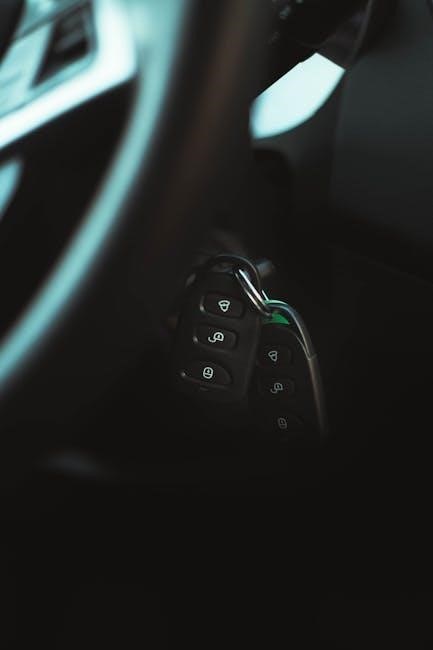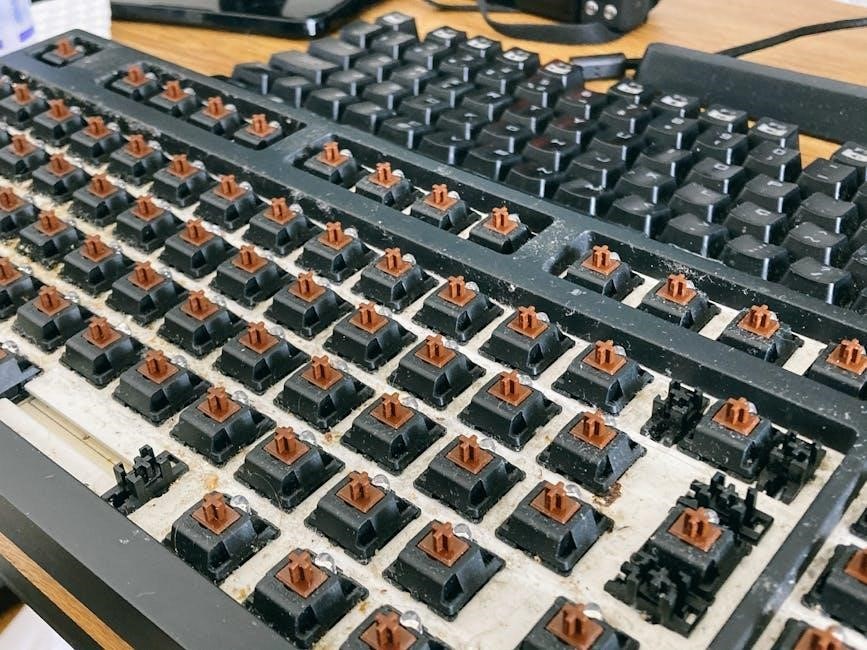This guide provides an overview of key switches, including their types and characteristics, to help users make informed decisions when choosing a keyboard that suits their needs and preferences perfectly always.
Understanding Mechanical Switches
Mechanical switches are a crucial component of mechanical keyboards, allowing for precise and tactile key presses. They consist of a mechanical mechanism that registers key presses, providing a unique typing experience. The switches are typically made up of a spring, a stem, and electrical contacts, which work together to register key presses. Understanding how mechanical switches work is essential to appreciating the benefits of mechanical keyboards. Mechanical switches come in various types, each with its own characteristics and advantages. They are designed to provide a specific typing experience, from linear and smooth to tactile and clicky. By understanding the mechanics of mechanical switches, users can make informed decisions when choosing a keyboard that suits their needs and preferences. This knowledge can also help users appreciate the craftsmanship and engineering that goes into creating high-quality mechanical keyboards. Overall, mechanical switches play a vital role in the world of keyboards.

Characteristics of Mechanical Switches
Key switches have distinct characteristics, including operation force and actuation point, affecting typing experience and keyboard functionality always with specific values for each characteristic clearly.
Operation Force and Typing Technique
Understanding operation force is crucial as it affects typing technique and overall keyboard experience. The force required to press a key can vary significantly between switch types. Lighter switches may be preferred by those who type frequently, while heavier switches may be suitable for gamers who require more forceful key presses. Additionally, operation force can impact typing accuracy and speed, making it essential to consider when selecting a keyboard. A switch with the right operation force can enhance typing comfort and reduce fatigue, leading to improved productivity and efficiency. By considering operation force and typing technique, users can choose a keyboard that meets their specific needs and preferences, resulting in a more enjoyable and effective typing experience. This consideration is vital for both casual and heavy keyboard users.

Types of Key Switches
Key switches come in various types, including linear, tactile, and clicky, each offering unique characteristics and typing experiences always with different characteristics and uses perfectly.
Linear Switches and Their Characteristics
Linear switches are a type of key switch that offers a smooth and consistent keystroke feel, with a linear force curve that requires the same amount of pressure from start to finish. They are often preferred by gamers and typists who value speed and accuracy, as they allow for quick and effortless keystrokes. The characteristics of linear switches include a low actuation force, a short actuation distance, and a smooth, linear motion. They are also known for their quiet and tactile-free operation, making them a great option for those who prefer a more subtle typing experience. Linear switches are available from various manufacturers, including Cherry and Gateron, and are commonly used in gaming keyboards and other high-performance applications, providing a unique and responsive typing experience. They are a popular choice among keyboard enthusiasts and are widely used in custom keyboard builds.
Tactile and Clicky Switches
Tactile and clicky switches are types of key switches that provide a distinct feedback mechanism, allowing users to feel and hear when a key is pressed. Tactile switches have a bump or notch that provides a tactile indication of key actuation, while clicky switches have a audible click sound. These switches are often preferred by typists who value feedback and accuracy, as they help to prevent typos and improve typing speed. The tactile and clicky characteristics of these switches make them well-suited for applications where feedback is important, such as in gaming and typing. They are available from various manufacturers and are commonly used in mechanical keyboards, providing a unique and engaging typing experience. Tactile and clicky switches are a popular choice among keyboard enthusiasts, offering a range of benefits and features that enhance the typing experience. They are widely used in custom keyboard builds and are known for their durability.
Importance of Key Switches in Keyboards
Key switches play a crucial role in keyboard functionality and user experience always with different types available.
Role of Mechanical Switches in Keyboard Functionality
Mechanical switches are essential components of keyboards, enabling efficient typing and gaming experiences. They allow for precise keystrokes, registering key presses quickly and accurately. The role of mechanical switches in keyboard functionality is multifaceted, influencing the overall performance and responsiveness of the keyboard. By providing tactile feedback, mechanical switches help users type more accurately and quickly. Additionally, they offer a range of actuation forces and switch types, catering to different user preferences and needs. Overall, mechanical switches play a vital role in determining the quality and usability of a keyboard, making them a crucial consideration for users seeking optimal typing and gaming experiences. Their impact on keyboard functionality is significant, and understanding their role is essential for making informed decisions when selecting a keyboard. This knowledge can help users choose the best keyboard for their specific needs.

Hot Swappable Key Switches
Hot swappable key switches offer flexibility and convenience, allowing users to easily swap switches without soldering, perfect for customizing keyboards to suit individual preferences and needs always perfectly.
Benefits and Examples of Hot Swappable Keyboards
The benefits of hot swappable keyboards include ease of switch replacement, reduced electronic waste, and increased customization options. Examples of hot swappable keyboards include the Epomaker GK series, which allows users to easily swap switches without soldering. This feature is particularly useful for those who want to try out different switch types or replace worn-out switches. Hot swappable keyboards also provide a cost-effective solution for users who want to upgrade their keyboard without having to purchase a new one. Additionally, hot swappable keyboards offer a range of switch options, including linear, tactile, and clicky switches, allowing users to choose the switch that best suits their typing style and preferences. Overall, hot swappable keyboards provide a convenient and customizable typing experience. They are suitable for various applications, including gaming, typing, and programming, and are a great option for those who value flexibility and ease of use.




